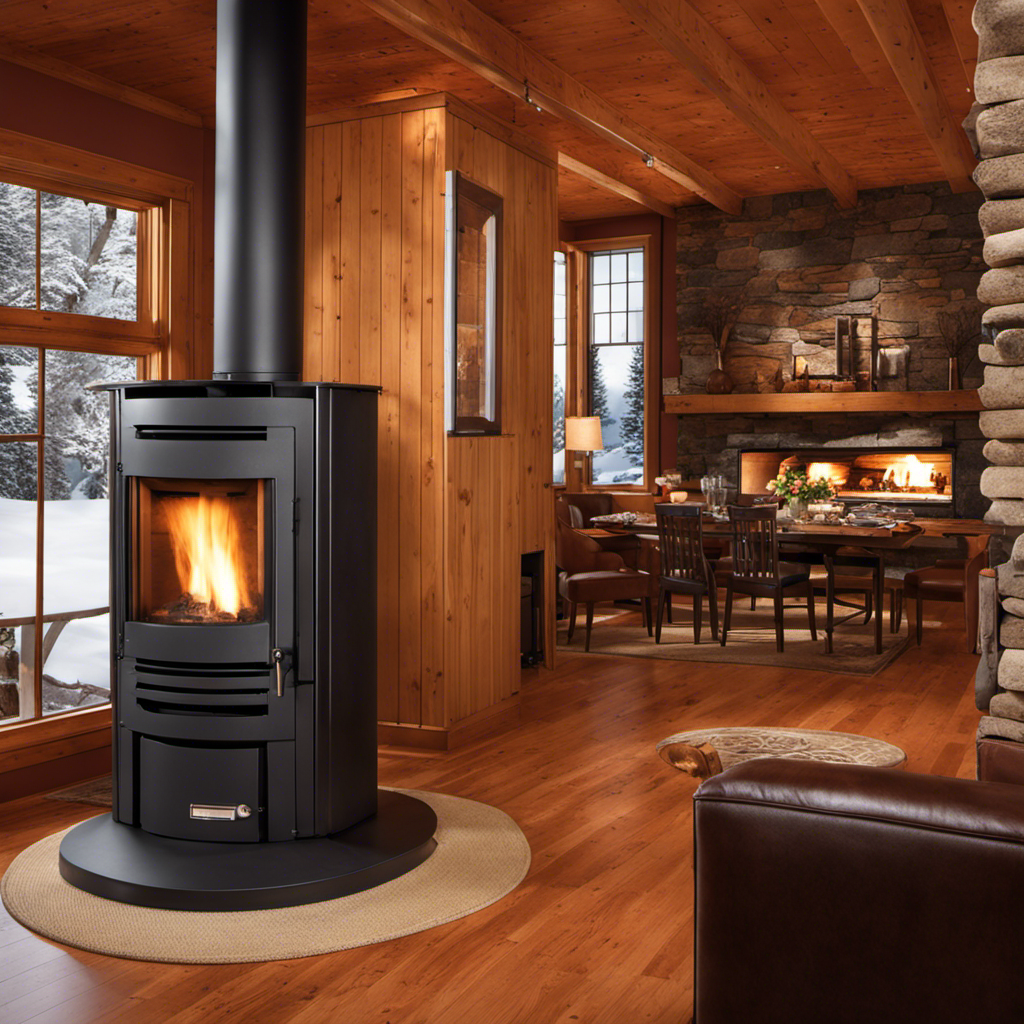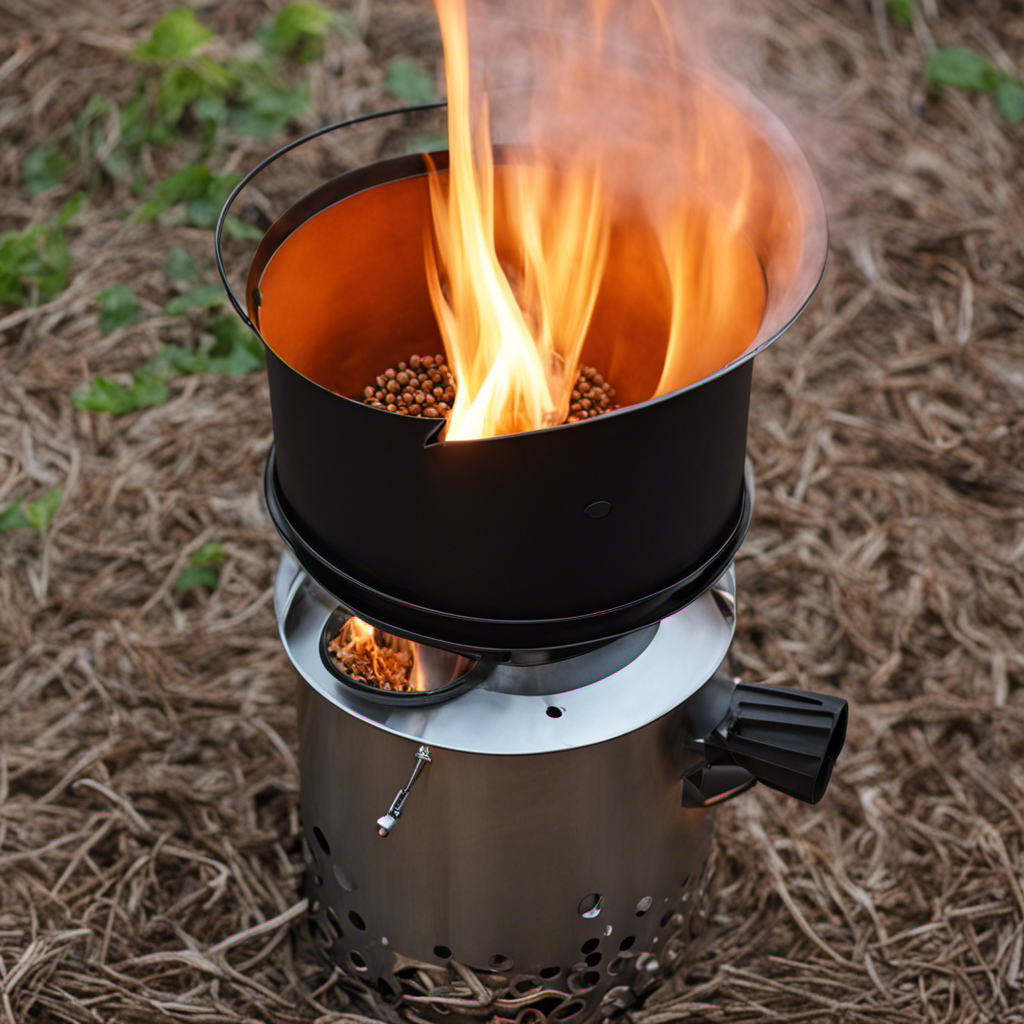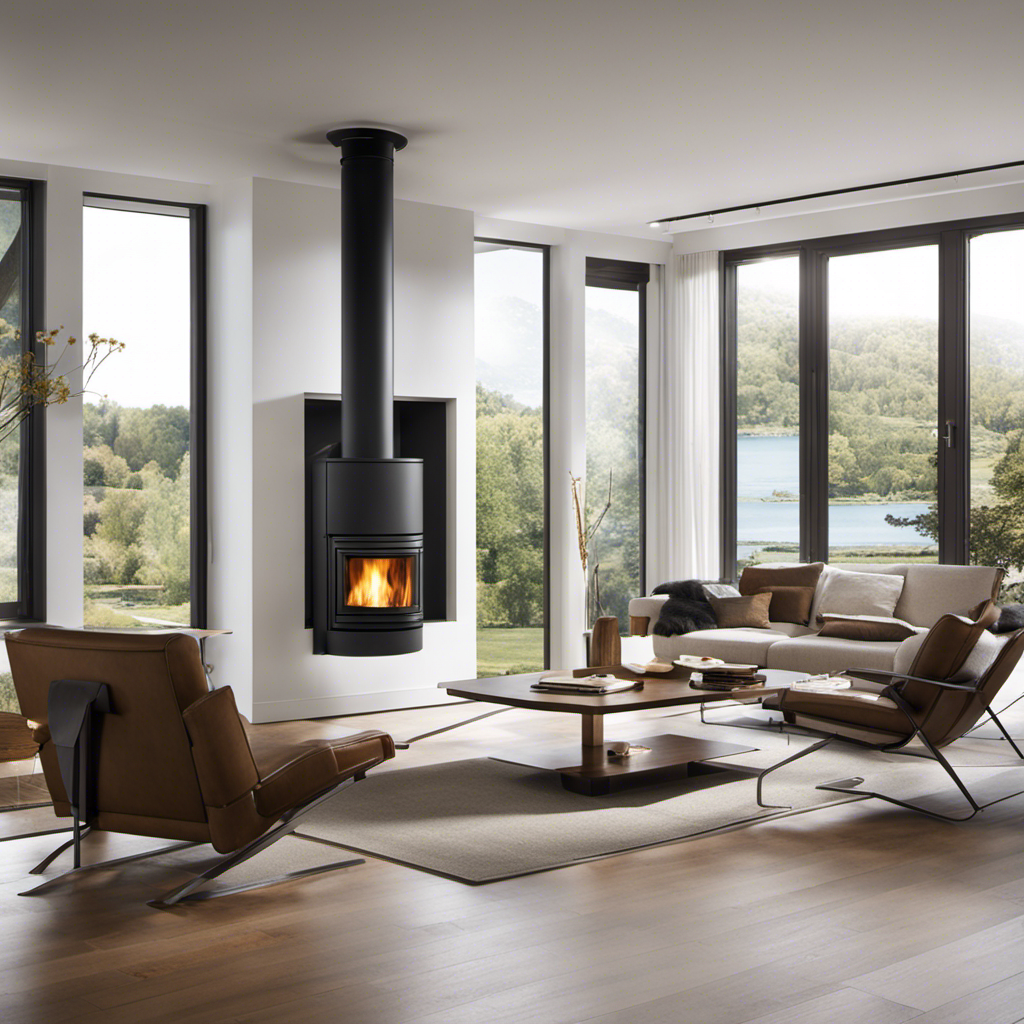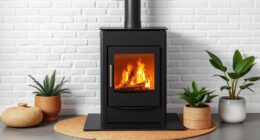I’ve personally discovered how vital it is to keep a wood pellet grill clean in order to maintain its functionality and extend its lifespan. Consistent cleaning is crucial not only for making sure the food remains delicious but also to prevent excessive grease build-up and reduce the danger of fire hazards.
In this article, I’ll guide you step-by-step on how to effectively clean your wood pellet grill, from preparing it for cleaning to properly storing it afterwards. Let’s dive in and make your grill shine like new!
Key Takeaways
- Regular cleaning and maintenance are important for maintaining grill performance and prolonging its lifespan.
- Having the necessary supplies and tools, such as a wire brush, scraper, and long-handled brush, is essential for effective cleaning.
- Proper cleaning techniques, such as removing leftover ash, cleaning grates, and using a specialized grill cleaner or vinegar and water for stubborn grease, are crucial for thorough cleaning and sanitizing.
- Grease disposal methods, such as regularly emptying the drip bucket, using absorbent materials, and disposing of grease responsibly, should be followed to prevent overflow and fire hazards and protect the environment.
Importance of Regular Cleaning
Regular cleaning is important to keep your wood pellet grill in optimal condition. As someone who has years of experience maintaining and cleaning wood pellet grills, I can assure you that following the right cleaning techniques and maintenance tips is crucial for the longevity of your grill.
Not only does regular cleaning remove built-up grease and food residue, but it also prevents rust and ensures proper functioning of your grill. By regularly cleaning your grill, you can avoid unpleasant flavors in your food and potential health hazards.
Now that you understand the importance of regular cleaning, let’s move on to gathering the necessary supplies for the cleaning process.
Gathering the Necessary Supplies
When it comes to cleaning, having the right tools is essential for achieving the best results. From scrub brushes to microfiber cloths, there are a variety of cleaning tools that can make your job easier and more effective.
Additionally, knowing the proper cleaning techniques is crucial for ensuring that you are able to thoroughly clean and sanitize your space.
Essential Cleaning Tools
To properly clean your wood pellet grill, you’ll need a few essential tools. Regular maintenance is crucial for the longevity and performance of your grill.
One of the most important tools for cleaning is a wire brush. This sturdy brush will help you remove any built-up grease and food particles from the grates.
Additionally, a scraper or putty knife can be helpful for loosening stubborn grease. For those hard-to-reach areas, a long-handled brush or grill brush with bristles on all sides can be beneficial.
These tools will ensure that you can thoroughly clean every inch of your grill.
Now that you have the necessary tools, let’s move on to the proper cleaning techniques.
Proper Cleaning Techniques
Once you’ve gathered the essential cleaning tools, it’s important to know the proper techniques for maintaining your wood pellet grill. Here are some tips to help you keep your grill in top shape:
- Start by removing any leftover ash from the fire pot and the bottom of the grill.
- Use a grill brush to clean the grates and remove any food residue.
- Wipe down the exterior of the grill with a damp cloth and mild soap.
- For stubborn grease and grime, use a specialized grill cleaner or a mixture of vinegar and water.
- Don’t forget to clean the grease drip tray and replace the aluminum foil liner if necessary.
Proper cleaning techniques, along with the best cleaning products, will ensure that your wood pellet grill stays in great condition.
Now, let’s move on to preparing the grill for cleaning by removing any remaining charcoal and disconnecting the propane tank.
Preparing the Grill for Cleaning
When it comes to cleaning my wood pellet grill, I have found that having the right tools at hand is crucial. A wire brush, a scraper, and a bucket of soapy water are my go-to cleaning supplies.
Once I have the necessary tools, I start by disassembling the grill properly, removing the grates, drip tray, and any other removable parts. This allows me to access all the nooks and crannies where grease and residue tend to build up.
Lastly, I focus on removing the stubborn grease and residue by scrubbing with the wire brush and using the scraper to scrape off any stuck-on debris.
Cleaning Tools Needed
Make sure you have all the cleaning tools you’ll need, such as a grill brush and a bucket of warm soapy water. When it comes to cleaning your wood pellet grill, having the right tools is essential. Here are some must-have cleaning tools for the job:
| Tools | Description |
|---|---|
| Grill brush | Used to remove food residue and debris from grates |
| Bucket | Filled with warm soapy water for cleaning |
| Cleaning cloth | Used to wipe down surfaces and remove grease |
These tools will help you tackle the cleaning process efficiently and effectively. With the right cleaning techniques and proper disassembly, you can ensure that your wood pellet grill stays in top shape. Now, let’s move on to the next section and learn about the proper grill disassembly.
Proper Grill Disassembly
Now that we have gathered the necessary cleaning tools, it’s time to properly disassemble the wood pellet grill for thorough cleaning.
As an experienced grill enthusiast, I understand the importance of dismantling the grill in a methodical manner to ensure a smooth reassembly later on.
First, I recommend removing all the cooking grates, heat diffuser, and drip tray. These components can be soaked in warm soapy water to remove any grease and residue.
Next, carefully detach the fire pot and clean it separately to ensure it is free from any debris.
While disassembling, pay close attention to any screws or bolts that need to be removed. Keep them in a safe place to avoid misplacing them during the cleaning process.
To prevent rust, make sure to dry all the components thoroughly before reassembling the grill. Additionally, consider applying a light coat of cooking oil to any metal parts that are prone to rusting.
Now that we have properly disassembled the grill, it’s time to move on to the next section: removing grease and residue.
Removing Grease and Residue
After properly disassembling the grill, it’s essential to tackle the task of removing grease and residue. When it comes to grease removal techniques, I have found that using a degreaser specifically designed for grills works best.
Simply spray the degreaser onto the greasy areas and let it sit for a few minutes to break down the grease. Then, using a grill brush or a scrubbing pad, scrub away the grease and residue. For tougher stains, you can also use a mixture of baking soda and water to create a paste, which can be applied to the affected areas.
As for residue cleaning methods, a mixture of warm water and dish soap usually does the trick. Dip a sponge or cloth into the soapy water and scrub away any residue left on the grill grates or other surfaces.
Once you have thoroughly cleaned the interior of the grill, it’s time to move on to cleaning the exterior surfaces, which I will discuss in the next section.
Cleaning the Exterior Surfaces
To clean the exterior surfaces of your wood pellet grill, start by wiping them down with a damp cloth. This will remove any dust or debris that may have accumulated.
As part of exterior surface maintenance, it is important to use weatherproofing techniques to protect your grill from the elements. Consider applying a coat of high-quality wood sealer to keep the wood in optimal condition. Additionally, using a grill cover when not in use can protect it from rain, snow, and UV rays.
Regularly inspect the exterior for any signs of wear or damage, and address them promptly to prevent further issues.
Now, let’s move on to removing and cleaning the grease tray, ensuring your grill is not only clean on the outside but also on the inside.
Removing and Cleaning the Grease Tray
When it comes to maintaining a wood pellet grill, there are a few key points to keep in mind.
Firstly, it’s important to know the proper grease disposal methods to avoid any potential hazards.
Secondly, understanding the recommended cleaning frequency will help ensure your grill stays in optimal condition.
Lastly, proper maintenance is crucial to prolonging the lifespan of your grill and ensuring it continues to perform at its best.
Grease Disposal Methods
You can easily dispose of grease from your wood pellet grill using a drip bucket. Here are three effective grease disposal methods that I recommend:
-
Empty the drip bucket regularly: After each grilling session, remove the drip bucket and empty the accumulated grease into a heat-resistant container. This prevents any overflow or potential fire hazards.
-
Use absorbent materials: Place absorbent materials such as paper towels or cat litter in the drip bucket to soak up the grease. This makes it easier to dispose of the grease and keeps the bucket clean.
-
Dispose of grease responsibly: Do not pour the grease down the sink or toilet, as it can cause clogs. Instead, seal the container with the collected grease and dispose of it in the trash.
Properly disposing of grease not only ensures a clean grill but also protects the environment.
Now, let’s talk about the recommended cleaning frequency for your wood pellet grill.
Cleaning Frequency Recommendations
It’s important to maintain a regular cleaning schedule for optimal performance and longevity of your grill. Regular cleaning not only keeps your grill looking great, but it also ensures that it functions at its best.
Cleaning frequency recommendations may vary depending on how often you use your grill, but a general rule of thumb is to clean it thoroughly after every 5-10 uses. By doing so, you prevent grease buildup, which can cause flare-ups and affect the taste of your food.
Additionally, regular cleaning helps to prevent rust and corrosion, extending the lifespan of your grill. By taking the time to clean your grill regularly, you’ll reap the benefits of a well-maintained and efficient cooking appliance.
Now, let’s delve into the importance of proper maintenance…
Importance of Proper Maintenance
Regular maintenance is crucial to keep your grill in optimal condition and extend its lifespan. By properly maintaining your grill, you can prevent rust and ensure it continues to perform at its best.
One of the most important aspects of maintenance is preventing rust. This can be achieved by regularly cleaning and drying the grill, especially after each use. Moisture and debris can accumulate and lead to rust, so it’s essential to remove them promptly.
Inspecting and tightening any loose screws or parts can also help prevent rust from forming. Taking these preventive measures will not only keep your grill looking great, but it will also extend its lifespan.
Now, let’s move on to the next section about cleaning the drip pan and heat deflector.
Cleaning the Drip Pan and Heat Deflector
To clean the drip pan and heat deflector, start by removing them from your wood pellet grill. This is an important step in maintaining the overall cleanliness and functionality of your grill.
First, make sure the grill has cooled down completely to avoid any burns. Once removed, use a grill brush or scraper to remove any excess grease or debris from the drip pan and heat deflector. This will help prevent any potential flare-ups during cooking and ensure a more even heat distribution.
It is also a good idea to inspect the drip pan and heat deflector for any signs of damage or rust, as this can affect the performance of your grill.
With the drip pan and heat deflector clean and in good condition, you can now move on to scrubbing the grill grates, which will further enhance your grilling experience.
Scrubbing the Grill Grates
After removing the drip pan and heat deflector, start by scrubbing the grill grates to remove any residue or buildup. Grill grate maintenance is crucial for ensuring optimal grilling performance and prolonging the lifespan of your wood pellet grill. To deep clean the grates, I recommend using a wire brush or grill brush specifically designed for this purpose. Scrub the grates in a back-and-forth motion, applying firm pressure to dislodge any stubborn grime. For a more thorough cleaning, you can also soak the grates in warm, soapy water for a few minutes before scrubbing. Here’s a handy table to summarize the grill grate maintenance process:
| Step | Action |
|---|---|
| 1 | Remove grates from the grill |
| 2 | Scrub with wire brush or grill brush |
| 3 | Soak in warm, soapy water (optional) |
| 4 | Rinse and dry thoroughly |
| 5 | Reinstall grates on the grill |
Now that the grates are clean and ready for use, let’s move on to the next section: cleaning the fire pot and burn pot.
Cleaning the Fire Pot and Burn Pot
Once you’ve finished scrubbing the grill grates, it’s time to focus on the fire pot and burn pot. These components are crucial for proper functioning of your wood pellet grill, so it’s important to keep them clean.
Start by removing any ash or debris from the fire pot using a brush or vacuum. Next, inspect the burn pot for any leftover pellets or residue. Use a scraper to gently remove any buildup, being careful not to damage the pot. If you encounter stubborn residue, you can soak the burn pot in warm soapy water and scrub it clean.
Additionally, don’t forget to clean the ash tray, as it collects ash and can affect the grill’s performance if not emptied regularly.
Troubleshooting common cleaning issues, such as clogged fire pots or excessive ash, can often be resolved by ensuring proper cleaning and maintenance of these components.
Now, let’s move on to clearing the auger and pellet hopper, ensuring smooth operation of your wood pellet grill.
Clearing the Auger and Pellet Hopper
Don’t forget to regularly clear the auger and pellet hopper to ensure smooth operation of your grill. Here are four important steps to follow when clearing the auger and pellet hopper:
-
Turn off and unplug the grill: Safety is always the priority. Make sure the grill is turned off and unplugged before starting the cleaning process.
-
Empty the pellet hopper: Remove any remaining pellets from the hopper. This will prevent them from getting stuck and causing blockages in the auger.
-
Clear the auger: Use a shop vac or a long wire brush to remove any leftover pellets or debris from the auger. This will ensure that the pellets flow smoothly through the system.
-
Clean the ash drawer and chimney cap: Don’t forget to clear the ash drawer and clean the chimney cap. This will help prevent any buildup that could affect the performance of your grill.
Properly Storing the Grill After Cleaning
To ensure your grill remains in good condition, it’s important to properly store it after cleaning.
Proper grill storage is crucial for preventing rust and prolonging the lifespan of your grill. After cleaning, make sure the grill is completely dry before storing it. Any moisture left on the grill can lead to rust formation.
To further protect against rust, it’s recommended to cover the grill with a weather-resistant grill cover. This will shield the grill from any moisture in the air and prevent dust or debris from accumulating on the surface.
Additionally, if you live in an area with harsh winters, consider storing your grill in a dry and sheltered area to provide extra protection against the elements.
Following these steps will ensure your grill stays in excellent condition for years to come.
Frequently Asked Questions
How Often Should I Clean My Wood Pellet Grill?
I clean my wood pellet grill every 4-6 weeks to maintain optimal performance. To clean the grates, I scrape off any residue and then wipe them down with a damp cloth. Regular maintenance is key to keeping your grill in top shape.
Can I Use Regular Household Cleaners to Clean the Exterior Surfaces of My Grill?
Regular household cleaners may not be the best option for cleaning the exterior surfaces of a wood pellet grill. It is recommended to use specific cleaning products designed for grills to ensure proper cleaning and maintenance.
Is It Necessary to Remove and Clean the Grease Tray Every Time I Use the Grill?
Yes, it’s necessary to remove and clean the grease tray after each use. Proper grease management is crucial for maintaining a clean and efficient grill. Regular maintenance ensures better cooking results and prolongs the lifespan of your grill.
How Do I Clean the Fire Pot and Burn Pot of My Wood Pellet Grill?
To clean the fire pot and burn pot of a wood pellet grill, I recommend following these best practices. First, ensure the grill is cool before removing any accessories. Then, carefully clean the pots using a grill brush and hot soapy water.
Can I Store My Grill Outside After Cleaning, or Should It Be Stored Indoors?
After cleaning, it’s best to store your wood pellet grill indoors. Outdoor storage can expose it to the elements and potentially damage the grill. Follow proper cleaning practices to maintain the grill’s longevity.
Conclusion
In conclusion, regular cleaning of your wood pellet grill is essential for maintaining its performance and extending its lifespan.
By following the steps outlined in this article, you can ensure that your grill is always in top shape and ready for your next barbecue.
So why wait? Take the time to clean your grill today and enjoy the benefits of a well-maintained cooking appliance.
After all, isn’t it worth it to have a grill that consistently delivers delicious, smoky flavors?
Logan’s affair with adventure began in childhood. He hailed from a small town where vast forests bordered one side and endless shores stretched on the other. His days were spent exploring uncharted woods, climbing tall trees, or listening to the tales of old sailors. This early immersion in a world brimming with stories and mysteries became the foundation of his passion for writing.











